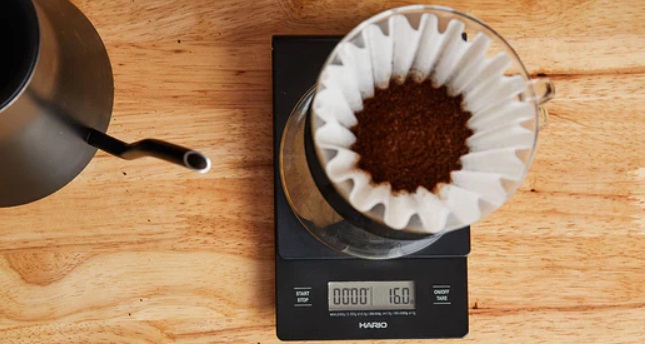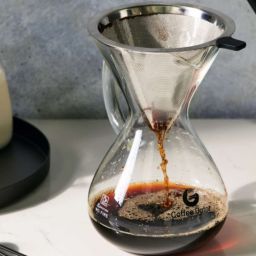
Whether you’re a seasoned barista or a curious newbie, getting this ratio right can elevate your coffee game to new heights. It’s not just about following a recipe; it’s about understanding how each element comes together to create that perfect cup of coffee. So, let’s get started and unlock the secrets of the pour-over method!
Key Takeaways
- Coffee Bean Type Matters: Different beans have different characteristics. A light roast might be floral and bright, while a dark roast could be rich and chocolaty. Experiment with various types to find your favorite.
- Grind Size is Key: The grind size can make or break your brew. Too coarse and your coffee will be under-extracted (think sour and watery); too fine and you might end up with an over-extracted brew (bitter and harsh). Aim for a medium grind as a starting point.
- Water Temperature is Crucial: The ideal temperature for brewing pour-over coffee is between 195°F and 205°F. Too hot, and you risk burning the coffee; too cool, and you won’t extract enough flavor.
- Brewing Devices Vary: Whether you’re using a Chemex, V60, or another pour-over brewer, each one has its nuances. Get to know your device and how it interacts with your coffee.
The Ideal 16 Oz Pour Over Coffee Ratio
Let’s cut to the chase: finding the ideal pour-over coffee ratio for 16 oz is your ticket to a consistently great cup of coffee. The sweet spot? Typically, it’s between a 1:14 and 1:20 coffee-to-water ratio. This means for every gram of coffee, you’d use 14 to 20 grams of water. For a 16 oz (about 473 ml) brew, you’re looking at using approximately 24 to 34 grams of coffee, depending on how strong you like it. But remember, coffee is a personal affair, so feel free to tweak this range until you find your perfect match.
Detailed Breakdown of Factors Influencing the Coffee Ratio
Type of Coffee Beans and Their Impact: Not all beans are created equal. The variety, origin, and roast level of your beans can significantly affect your brew. Light roasts tend to be more acidic and complex, while dark roasts offer a bolder, more robust flavor. Your ideal ratio might shift slightly depending on the bean’s profile, so don’t be afraid to adjust.
Choice of Brewing Device: Your choice of brewing device plays a crucial role too. Different devices can affect the extraction and the final taste. For example, a Chemex might require a slightly different approach compared to a Hario V60. Get to know your brewing device and how it interacts with different coffee-to-water ratios.
The Role of Water Temperature: Water temperature is critical. Too hot, and you might extract unwanted bitterness; too cool, and your coffee could be underwhelming. Aim for that goldilocks zone between 195°F and 205°F. Consistent temperature ensures that you extract the full spectrum of flavors from your beans, giving you a balanced and enjoyable cup every time.
Using a Scale for Accuracy
To nail that perfect cup, precision is key. A digital scale is your best friend in the world of pour-over coffee. It eliminates guesswork, ensuring you use the exact amount of coffee and water every time. Start by weighing your coffee to the gram, then measure your water. This consistency is what will bring you closer to your ideal cup.
Adjusting Based on Taste
Taste is subjective, and the perfect cup of coffee is no exception. If your brew is too bitter, try reducing the amount of coffee or coarsening the grind. If it’s too weak for your liking, increase the coffee amount or use a finer grind. Remember, small adjustments can make a big difference.
The Brewing Process Step-by-Step
- Grind Your Coffee: Aim for a medium-fine consistency, similar to table salt.
- Heat Your Water: Get it to that sweet spot between 195°F and 205°F.
- Wet the Filter: Pre-wet your filter to get rid of any papery taste and preheat your brewer.
- Bloom Your Coffee: Pour just enough water to saturate the grounds and let them bloom for about 30 seconds.
- Pour and Brew: Pour the rest of the water in a slow, steady spiral, starting from the center and moving outward.
The Art of the Pour and Brewing Time
The way you pour water over the coffee grounds can significantly affect the extraction process and the final taste of your coffee. A slow and steady pour ensures even saturation, which is crucial for a balanced extraction. Start with a circular motion at the center, gradually moving outwards, then back to the center.
The brewing time is just as crucial. Typically, for a pour-over, you’re looking at a brewing time of about 3 to 4 minutes. If the brew time is too short, your coffee may be under-extracted, lacking in flavor. If it’s too long, you risk over-extraction, leading to bitterness.
Troubleshooting Common Pour Over Coffee Problems
Encountering issues with your pour-over? Don’t worry; you’re not alone. Here’s how to tackle some common problems:
- Incorrect Coffee-to-Water Ratios: If your coffee tastes off, revisit your ratio. Too weak? Add more coffee next time. Too strong? Reduce the coffee or increase the water.
- Poor-Quality Coffee Beans: The quality of your beans is crucial. If your coffee lacks flavor, consider switching to a higher-quality, freshly roasted bean.
- Incorrect Brewing Times: Timing is everything. If your coffee is too bitter, try reducing the brew time. If it’s too sour, extend it a bit to ensure full extraction.
FAQs
How do you bloom coffee?: Blooming is the process of pouring a small amount of hot water over the grounds to release gases and start extraction. Just pour enough water to wet the grounds and wait about 30 seconds before continuing your pour.
What’s the difference between pour-over and French press?: Pour-over coffee is generally lighter and clearer in flavor, as it uses a paper filter. French press coffee is typically richer and fuller-bodied since it allows more oils and fine particles into the final cup.
Final Thoughts
Mastering the pour-over technique is a journey, one that’s unique to each coffee lover. Remember, the perfect cup is about finding what tastes best to you. So, experiment with the ratio, grind size, water temperature, and brewing time until you hit your sweet spot. Embrace the process, and enjoy the delicious rewards of your craft!









